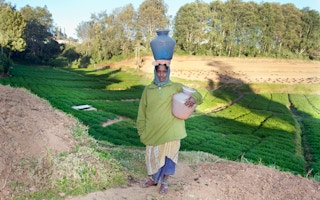As farmers once again protest in India – three years on from the biggest peaceful civil society protest in the world – it is worth remembering that agriculture was also a critical issue for the nation in its first decades. The country’s first prime minister, Jawaharlal Nehru, bluntly stated that “everything can wait, but not agriculture.”
This line of thinking eventually led to the Green Revolution of the late 1960s, forging India’s food security and providing much-needed revenue for some of its farmers. But back in the present, a looming water crisis has returned Indian agriculture to the spotlight.
Farmers’ grievances
The Green Revolution harnessed high-yield grain varieties, water-intensive practices (largely reliant on pumped groundwater) and heavy fertiliser use. Understanding that such investments would not be made by farmers without a guaranteed market, the Indian government also created a minimum support price (MSP) for wheat in 1966-67.
This set a base price for government procurement at a certain percentage above input costs, and therefore guaranteed farmers an assured buyer: even if the majority of the crop was not bought by the government, the MSP set a floor price for other buyers.
Today, the MSP regime covers 23 crops: varieties of cereals, pulses and some cash crops like sugarcane and cotton. It has been very successful in incentivising food production. So, instead of having to import grain as was the case before the Green Revolution, by 2017 India was the world’s largest producer of pulses and jute and the second-largest producer of wheat, rice and sugarcane.
But only the MSP for sugarcane is guaranteed under the Essential Commodities Act of 1955; at their heart, the most recent farmers’ protests in India are a call for the entire MSP regime to be legalised. To many Indian farmers, this is the only guarantee of some level of financial security. However, the gains of the Green Revolution and the MSP regime (in its current form) are currently being undone by a series of challenges, including water.
Finite resources pushed to the brink
In 19th-century India, the British viceroy Lord Curzon described the Indian economy as “a gamble on the monsoons”. When India began extracting its groundwater this issue faded, but new challenges were created. India is now the biggest user of groundwater in the world and water levels across India have plummeted accordingly: in 2022, the condition of 12 per cent of India’s aquifers were categorised by the government as “semi-critical”; 4 per cent as “critical”; and 14 per cent as “overexploited”.
With 87 per cent of extracted groundwater in India used for irrigation, the future looks bleak. A 2019 Indian government report estimated that 74 per cent of the area where wheat is cultivated, and 65 per cent of the area where rice is grown, will face water shortages. The most severely impacted parts of India are the semi-arid zones in its north-western region, where the planting of wheat and paddy (which form the bulk of government procurement) is the most intense. This is where most of the protesting farmers come from.
The over-extraction of groundwater has also led to higher concentrations of arsenic. This has triggered long-running health crises in states including Punjab, Uttar Pradesh, Bihar and West Bengal.
Lastly, this focus on a limited range of crops means the vast majority of indigenous seeds are disappearing. And that threatens a future for India in which it may be dependent on just a few types of seeds.
A larger water crisis impacts agriculture
All of this is happening in the context of a challenging water future. India’s population number has taken off since independence, but its water resources remain the same. Water availability is estimated to be under 1,486 cubic metres per person, which is alarming given that 1,700 cubic metres is usually considered the benchmark for water stress.
Meanwhile, the latest report on the Himalayan region by the International Centre for Integrated Mountain Development (ICIMOD) estimates the region will hit “peak water” by 2050, after which water availability will decline.
Inadequate government response
The Green Revolution was conceptualised at a time when India had far less resources to understand its water needs, but half a century later, the government has nothing new to offer.
In September 2020, it passed three farm laws that were repealed in November 2021. The laws pushed for greater market access, contract farming, and less regulation of essential commodities. They did not guarantee MSPs and in response, a number of state governments passed laws that did guarantee MSPs.
The weakening of the MSP regime was seen as an additional threat to the financial security of farmers, who are already dealing with lowered water tables, climate-induced floods and drought exacerbation, fluctuating monsoons and degraded soils from excessive fertiliser use – while these laws might have lowered procurement costs for the government, they did nothing to deal with the farming community’s myriad water issues.
As the agricultural expert Devinder Sharma points out, farmers currently earn about INR 27 (USD 0.33) per day from farming: they need more support, not less.
India gained independence in the wake of the Bengal famine in 1943, in which millions starved to death. Today, hundreds of millions reliant on agriculture face a catastrophic future as water availability dwindles. The government should know by now that everything can wait, but not agriculture.
This story was published with permission from The Third Pole.








